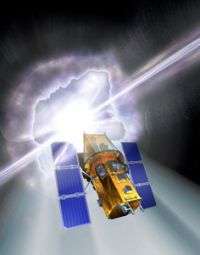Magnetic Power Revealed in Gamma-Ray Burst Jet

(PhysOrg.com) -- A specialized camera on a telescope operated by U.K. astronomers from Liverpool has made the first measurement of magnetic fields in the afterglow of a gamma-ray burst (GRB). The result is reported in the Dec.10 issue of Nature magazine by the team of Liverpool John Moores University (LJMU) astronomers who built and operate the telescope and its unique scientific camera, named RINGO.
The burst occurred January 2, 2009. NASA's Swift satellite observed its position and immediately notified telescopes all over the world via the Internet. When it received the trigger from Swift, the robotic Liverpool Telescope on the island of La Palma in the Canary Islands automatically swung to observe the burst. Its special camera employs a spinning disk of Polaroid -- similar to the material used in sunglasses.
"By observing how the brightness of the GRB varied as we spun the Polaroid, we could measure the magnetic field in the burst," explained Iain Steele, Director of the Liverpool Telescope.
"This important result gives us new insight into the physics of these remarkable objects and is a testament to the close collaboration between observers, theoreticians and technologists in the Liverpool and NASA Swift teams," added LMJU team leader Carole Mundell. "It's incredible to think that the GRB discovery and our measurement process - from first detection and notification by NASA's Swift satellite to the polarization measurement using RINGO on the Liverpool Telescope - took place completely automatically within less than three minutes and with no human intervention!"
"This breakthrough observation gives us the first measurement of magnetic fields in the afterglow of a GRB," said Swift lead scientist Neil Gehrels, Swift lead scientist at NASA's Goddard Space Flight Center in Greenbelt, Md.
Gamma Ray Bursts form when the core of a massive star collapses or when two neutron stars merge together. The resulting explosions are the brightest events in the universe and vastly outshine entire galaxies containing hundreds of billions of stars. NASA's Swift satellite sees about 100 of these events each year, triggering ground-based follow-up by observations across the globe.
Polarization is one of the least-observed properties in astronomy. This finding opens the door to understanding the role of magnetic fields in some of the most powerful events in the universe.
"These very interesting observations raise the possibility that gamma-ray bursts are not fireballs as usually presumed but are powered and collimated by an organized electromagnetic field," said Roger Blandford, Director of the Kavli Institute of Particle Astrophysics and Cosmology at Stanford University, California, commenting on the result's importance. "It will be very interesting to see if there are similarities in observations of other kinds of cosmic jets."
Source: NASA's Goddard Space Flight Center (news : web)

















